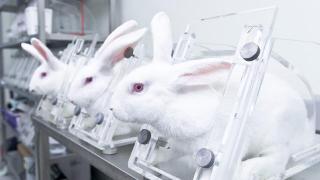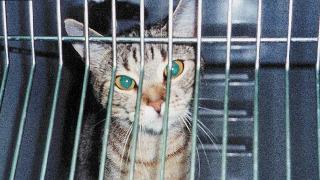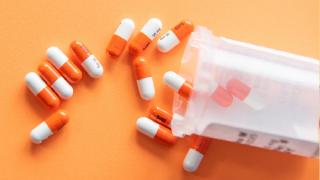Animals are suffering and dying in a range of cruel tests
Basic research
Basic biological research constitutes the most common use of animals in experiments around the world. These experiments are designed to answer ‘interesting’ scientific questions that animal researchers speculate might be useful medically in the future. It does not involve the testing of new medicines for humans or other animals and is conducted entirely on a voluntary basis.
This type of curiosity-driven research is often carried out by universities and some examples include recreational drug research, psychology experiments and the development of ’animal models’ of neurological diseases such as Alzheimer’s and Parkinson’s.
The likelihood of such speculative research actually leading to advances in human medicine is very slim. One review of 101 high impact discoveries based on basic animal experiments found that only 5% resulted in approved treatments within 20 years. More recently, we conducted an analysis of 27 key animal-based ‘breakthroughs’ that had been reported by the UK press 25 years earlier. Mirroring the earlier study, we found only one of the 27 ‘breakthroughs’ had been realized in humans, and that was subject to several caveats.
Genetically modifying animals
The use of genetically modified animals (GM) has been an increasing trend for the last 30 years and while the sheer scale of GM animal use is difficult to determine, it is clearly responsible for year on year increases in animal numbers worldwide.
Mice and other animals are being bred with specific genes ‘knocked out (deleted)’ or ‘knocked in (inserted)’ into the cells of their bodies. Researchers focus on genes that may be relevant in human medical conditions.
Far from being harmless tests, suffering has been acknowledged at every step of the GM process. For example, many of the animals die while they are still babies because the defect they have is so severe. It is also an extremely wasteful process as a huge number of animals are often needed to produce just one specific type of GM animal who carries the desired traits.
Experiments using GM animals are unable to fully mimic complex human diseases, particularly those like cancers and heart disease that are more commonly caused by lifestyle and environmental factors, rather than genetics.
Regulatory testing
Regulatory testing is standardised testing designed to see if medicines, chemicals (including paints, dyes, inks, petrol products, solvents, tars and waste materials), pesticides, biocides, food additives, cosmetics and other products are safe for use, and that they do their job effectively.
In these experiments, animals are forced to eat or inhale substances, or have them rubbed onto their skin or injected into their bodies. The animals are then subjected to further monitoring and testing before almost always being killed, so that researchers can look at the effects on their tissues and organs.
Cruelty Free International is successfully encouraging regulators to delete tests that are no longer required from legislation and guidelines, and to adopt non-animal methods that have shown to be safe and effective.
However, progress remains slow and much more needs to be done. For example, hundreds of thousands of animals continue to be used worldwide for tests where there are available non-animal methods.
The science relating to animal experiments can be extremely complicated and views often differ. What appears on this website represents Cruelty Free International expert opinion, based on a thorough assessment of the evidence.
FIND OUT MORE ABOUT ANIMAL TESTING
Alternatives to animal testing
subtitle: Alternatives to animal tests are often cheaper, quicker and more effective.
Our History
subtitle: Established in 1898, Cruelty Free International is firmly rooted in the early social justice movement and has a long and inspiring history.
Alternatives to animal testing
subtitle: Alternatives to animal tests are often cheaper, quicker and more effective.
What is animal testing?
subtitle: Animals used in laboratories are deliberately harmed, not for their own good, and are usually killed at the end of the experiment.
Arguments against animal testing
subtitle: Animal experiments are cruel, unreliable, and even dangerous.
Facts and figures on animal testing
subtitle: Millions of animals are used and killed in the name of progress every year.






